



July 2013
IRIS
NASA’s Interface Region Imaging Spectrograph (IRIS) is on its way to study the sun. IRIS launched June 26th at 10:27 p.m. from Vandenberg Air Force Base in California aboard an Orbital Sciences Corp. Pegasus XL rocket deployed from an Orbital L-1011 aircraft. The rocket placed IRIS in a sun-synchronous polar orbit. This allows IRIS to study the sun almost continuously throughout its two year mission.
IRIS will study the interface between the sun’s photosphere and corona, a little understood region of the sun. The spacecraft will study how solar material moves, gathers energy and heats up in the sun’s atmosphere driving the solar wind. 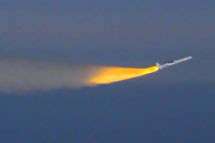 These emissions, along with ultraviolet radiation from this region of the sun, impact near-Earth environment and Earth’s climate. IRIS will use spectrometry and imaging along with state of the art 3-D modeling to help scientists understand this important region of the sun and solar emissions generated in it.
These emissions, along with ultraviolet radiation from this region of the sun, impact near-Earth environment and Earth’s climate. IRIS will use spectrometry and imaging along with state of the art 3-D modeling to help scientists understand this important region of the sun and solar emissions generated in it.
NASA
Andromeda Galaxy
NASA’s Chandra X-Ray Observatory has discovered a bonanza of black holes in the Andromeda Galaxy. Researchers have identified 26 more black hole candidates in Andromeda. This is the largest number to date found in a galaxy outside our own and is thought to be only the beginning of many more black hole discoveries in Andromeda. Nine black holes were previously identified and these new findings brings the total to 35.
These black hole candidates were formed when very massive stars, typically five to ten times the mass of our sun, went supernova. Astronomers can detect them as material is pulled from a companion star and heated up to produce radiation just before it is sucked into and disappears into the black hole.
Astronomers observe X-ray sources that have special characteristics. They have a certain high level of X-rays and a particular X-ray color. Neutron stars do not produce these two characteristics simultaneously, but black holes do. In this way, both black holes and neutron stars in Andromeda can be cataloged.
Unlike in the Milky Way, black holes have been found in globular clusters in Andromeda. Additionally, seven black holes have been identified within 1,000 light years of the Andromeda Galaxy center, which is more than identified near the center of the Milky Way. This is consistent with predictions as there are more stars in the middle of Andromeda allowing more black holes to form.
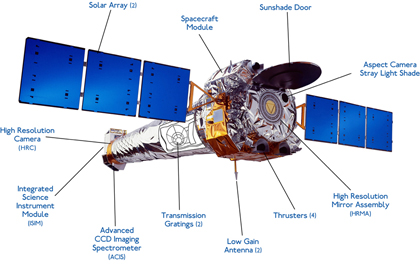
Chandra X-Ray Observatory
NASA
Visit our sponsors.
For advertising opportunities on this page and our videos, contact
Upcoming Launches
Date: July 24
Launch Vehicle: ISS Progress 52
Launch Site: Baikonur Cosmodrome, Kazakhstan
Description: Progress 52 will carry supplies, hardware, fuel and water to the International Space Station.
Hubble
Hubble may have found a planet being formed. The Hubble Space Telescope set its sights on the star TW Hydrae, a small red dwarf located 176 light years from Earth. TW Hydrae is only 8 million years old and has a disk of dust and gas swirling around it that is 41 billion miles wide. Hubble detected that there is a gap in the disk that is 1.9 billion miles wide. TW Hydrae is about half the size of our sun and the gap is at a distance from the star that would correspond to twice the distance Pluto is from our sun.
When a planet is being formed it collects the dust and rocks and gas from the disk and grows into a planet as it moves around the star. In this process it clears out a path for itself through the disk. This is what is being observed at TW Hydrae. But the situation at TW Hydrae goes against one of the main theories on planet formation that says it takes tens of millions of years for this to happen. A lot longer than TW Hydae has existed.
An alternate theory says that a piece of the disk can become unstable and collapse on itself forming a planet. This can take place in just a few thousand years, so it could be what is happening at TW Hydrae.
Additionally, the Atacama Large Millimeter Array in Chile has measured the dust grains at TW Hydrae and determined that dust grains the size of a grain of sand are not present beyond 5.5 billion miles from the star. That means, that at the gap where the planet may be forming, there are no large dust particles which theory says is needed in planet formation. So this gap at TW Hydrae poses a challenge to planet formation theories.
Measurements in all visible and near-infrared show the gap, which confirms it is actually there. Scientists now need to study the star and this gap further to try and explain the processes going on. This could lead to all new theories on planet formation.
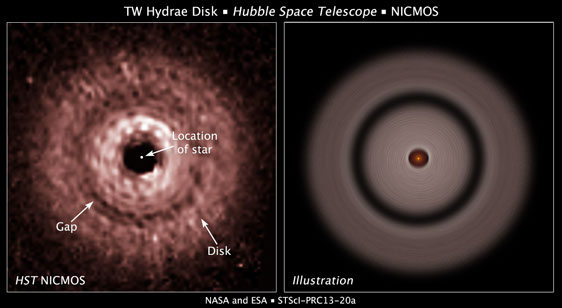
Mars
NASA’s Curiosity rover has found more evidence for an ancient flowing stream on Mars.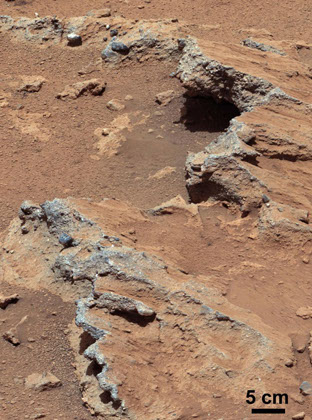
The rock outcrop pictured here is called “Hottah” after Hottah Lake in Canada’s Northwest Territories. Rounded pebbles indicate sustained abrasion of rock fragments that is caused when water flows over the rock. Hottah has pebbles of gravel embedded in it that are up to couple inches in size. As they are round in shape it can be concluded that they have been transported by a vigorous flow of water. The grains are too large to have been moved by wind.
NASA/JPL CalTech
Mercury
NASA administrator Charles Bolden and Italian Space Agency President Enrico Saggese signed a Memorandum of Understanding for cooperation between NASA and the European Space Agency (ESA) on the ESA led Bepi-Columbo mission to Mercury.
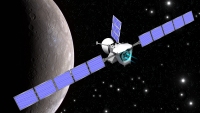 Bepi-Columbo is an ESA mission to the planet Mercury, now scheduled for launch in August 2015. ESA is also working with the Japanese Space Agency (JAXA) on the mission. Bepi-Columbo will consist of a carrier spacecraft and two separate orbiters, one developed by ESA and the other by JAXA.
Bepi-Columbo is an ESA mission to the planet Mercury, now scheduled for launch in August 2015. ESA is also working with the Japanese Space Agency (JAXA) on the mission. Bepi-Columbo will consist of a carrier spacecraft and two separate orbiters, one developed by ESA and the other by JAXA.
ESA
Venus
Venus’ winds have steadily been getting faster over the last six years. These finding come from ESA’s Venus Express spacecraft. Venus’ atmosphere rotates around the planet once every four Earth days. The planet itself only rotates once every 243 Earth days. Venus Express has monitored these winds over a period of 10 Venusian years (6 Earth years) tracking the clouds 70 km above the planet’s surface. In 2006, Venus Express clocked the winds at 300 km/hr. Over the years the winds have become faster and faster increasing to 400 km/hr today.
The cause or reasons for this are unknown. Further investigations are needed to explain what drives the atmospheric circulation patterns responsible.
Voyager
Voyager 1 is more than 11 billion miles (18 billion kilometers) from the sun and getting closer to becoming the first human-made object to reach interstellar space. Scientists expect to see three signs that Voyager has left the sun’s influence and entered interstellar space; the charged particles disappearing as they zoom out along the solar magnetic field, cosmic rays from outside zooming in, and an abrupt change in the direction of the magnetic field. The first two signs have happened, but not the third.
There has been a drastic reduction and rapid disappearance of particles originating from our sun, decreasing in intensity by over 1000 times. At the same time, cosmic rays are more populous. In a span of 24 hours the magnetic field from the sun began piling up, but the magnetic field direction changed by less than 2 degrees.
The Voyager spacecraft are in uncharted space. The two spacecraft were launched in 1977 and visited Jupiter, Saturn, Uranus and Neptune. Voyager 2 is about 9 billion miles (15 billion kilometers) from the sun. No one know exactly what the conditions are at the edge of our solar system. One cannot predict with accuracy when Voyager 1 will be totally in interstellar space, but it is getting close.
Gaia
Gaia is getting ready to launch. Final preparations have been completed and the spacecraft is ready to be moved to French Guiana for launch. A mission of the European Space Agency, Gaia will conduct a five year mapping of the stars.
Gaia will map over a billion stars into a highly accurate 3D map of the Milky Way. It will repeatedly observe and map the precise locations and motions of the stars. It will also take measurements of temperature, luminosity and composition. Gaia will look for previously unseen objects including asteroids, planets around other stars, and supernovae. Gaia has been dubbed ESA’s “discovery machine”.
The spacecraft will spin slowly, sweeping the cosmos with the largest digital camera ever flown in space at nearly a billion pixels. Gaia will measure a billion stars or roughly 1% of all the stars in the Milky Way. Each of the billion stars will be measured 70 times on average over the five year mission producing a map of unprecedented accuracy.
Gaia will launch later in 2013 on an Arianespace Soyuz rocket from French Guiana and will be positioned in orbit around the sun 1.5 million kilometers beyond Earth’s orbit at the L2 Lagrangian Point.
© 2014-2016 Ted Cook Productions LLC. - All Rights Reserved